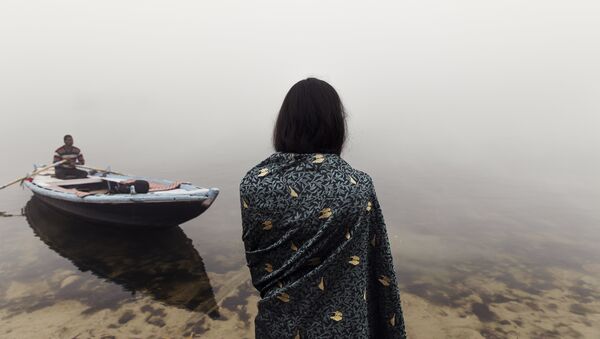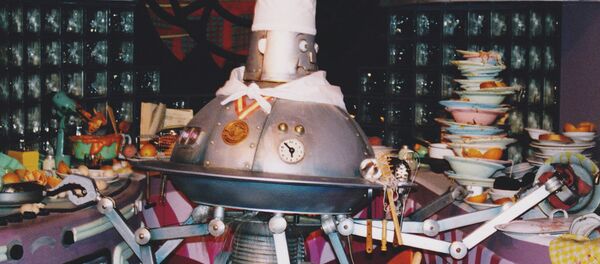New Delhi (Sputnik) — Palak Shah, CEO of the textile house Ekaya, which is in the news for its successful collaboration with French designers to evolve Parisian wedding gowns with Banarasi fabrics, says the designers never imagined the unique possibilities of the Indian handwoven textiles for French wedding couture.
Sputnik: We all know that fusion is leading the way in fashion and technology. How did you arrive upon the Indo-French collaboration, because this seems very unique?
Palak Shah: Every year, during the haute couture week, the Fédération Française de la Création Couture Sur Mesure — Paris, organizes an annual event which celebrates the know-how of its members in partnership with the greatest weavers of the world, in a luxurious and fashionable Parisian venue. For 2018, the federation presented "Cousu d'Or — Magical Weaving" launched on 29 January at the Sofitel Le Faubourg in collaboration with Ekaya, showcasing couture designs which demonstrate the mastery of the Indian textile craftsmanship. The theme of the collection is wedding couture, and they are essentially evening wear pieces.
READ MORE: India, ASEAN Explore Ways to Capture Global Textile Market
Sputnik: Tell our readers your story of becoming a celebrated designer and your focus on Banarasi sari.
Palak Shah: In India "the sari" is not just a garment, it's the master of identity, a style statement, and ever so often the sari says as much about a person as their region, religion or history. A sari can induce gasps at the mere sight of it. It is, therefore, in every sense a couture piece, yet it's rarely presented or sold that way.
The method of selling saris in the Indian retail sector had become outdated, the sari had begun to be perceived as an item meant for older or, rather, the "less fashionable" women. Ekaya was therefore born out of a dire need to reignite the mystique, romance, and allure of selling and presenting Indian handwoven textiles in a new, fresh and a contemporary way. Our objective was to communicate my passion for handlooms to a wide luxury-focused audience, and helping the products' artisanal value to rise, and attain its rightful place in the luxury bracket.

Sputnik: What has the response of the international audience been when you attempted taking the rustic Indian concepts to the world stage?
Palak Shah: There has been an overwhelming response from the French advocates. "Cousu d'Or" brings together design explorations new to both the French and Indian market. We were heartened to see how the designers from the federation responded and worked with the fabric. "Cousu d'or" introduces a physical intersection between France and India, with a collection that truly represents the best of both worlds and redefines the perception about Indian hand-woven crafts. The French designers bring a "new" perspective, where they are able to identify new details and values in textiles and apply them to a distinctly modern silhouette.
Sputnik: What next? Any new benchmark to achieve?
Palak Shah: As of now the main goal is expansion in India through more unique stores in metropolitan cities. We're also looking forward towards more interesting collaborations both in India and internationally, where we aim to continue introducing the Banarasi fabrics to the world in newer ways. As a brand, we want to break the stereotypical and mundane ways Indian fabrics are viewed and exhibited abroad, by puncturing the rules and conventions that are usually placed towards their usage.
We hope to take the Indian handloom textiles forward in a progressive way and a more global way. Our aim with this Paris exhibition was to break all notions and self-imposed limitations about the usage of the Indian textiles and truly make its reach limitless.

Our ultimate vision is to showcase Indian fabrics as "pieces of art" as well as expand its reach to an individual's everyday life. The Banarasi textile as a concept should become a vocabulary for everyone to know, where customers from all over the world are inspired to break away from conventional and traditional ways of using them.
READ MORE: New York Times Trolled for Ill-Researched Article on Indian Fashion
Sputnik: Banaras is the constituency of the Indian Prime Minister Narendra Modi. Did this factor help in anyway?
Palak Shah: Yes, because of this constituency, the Banarasi handloom has been a lot in the limelight and there have been a lot of positive conversations around it. The brand was fortunately launched around the same time. Thus stirring a lot of attention and support towards the brand and the initiatives it's taking to make the brand "India" global.
We have been involved in various government initiatives to help promote and sustain the Banarasi craft. We are dedicated to preserving and promoting the traditional weaving techniques. Our initiatives have garnered us immense support in the industry because of which, even though the brand is only five years old, it is reputed as a leading pioneer for handwoven textiles in India.
Sputnik: What is your message to Sputnik's readers?
Palak Shah: I would love for the readers to explore more about Indian Textiles and to open their minds and discover the limitless possibilities that Indian textiles have to offer.
Indian fabrics are exceptionally versatile; there is something for everybody, not just for the wedding market. Its variety is adaptable to the everyday wardrobe, to every type of season and every occasion. India is definitely going to become a major fashion destination; in fact, it is already gaining a lot of serious attention from the international industry.
Sputnik: Is India poised to become an important destination for fashion in coming years? What are the policy hurdles which you think the government should clear and help?
Palak Shah: The potential for its expansion and growth is immeasurable and one of the main reasons for that is its durability and versatility. In the changing fashion scenario brands and consumers are diverging towards more long-lasting and sustainable options. Indian textiles are extremely durable; they have the capacity to last generation, which makes the list of possibilities for Banarasi in the international market absolutely endless. It has the potential to become a vocabulary for everyone to know both nationally and internationally, where customers from all aspects of life are inspired to break away from conventional and traditional ways of using them.
A little more focus by the government on the handloom industry as a means of employment generation for an entire family of weavers can go a long way in improving the ground situation. It can prevent the shift of labor to other industries due to non-recognition of the craft.
Working in the handloom industry is a serious profession. It's a highly skilled, technical, artistic and laborious skill. A knowledge that takes years of practice and studies to acquire, it deserves the same amount of respect and recognition our economy gives to engineers or IT technicians. A lot of the new generation is not continuing with their family's weaving business because of the lack of respect for the skill, due to which we're losing future generations for the industry. Having fewer people weave is going to result in the industry dying, no matter how much business we create; so it is also important that the government focuses on turning this into a proper profession, which encourages more business development in the sector.
Moreover, I feel more relaxed foreign trade and investment policies will only make this industry grow. To facilitate more such collaboration, we would need the support of the government to make the exchange of ideas between two or more nations seamless.



